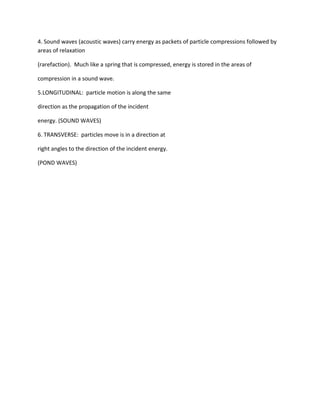Ang uri ng mga panitikan
- 1. Ang Uri ng mga Panitikan I. SALAYSAYIN BAYAN Alamat Epiko Kwentong Bayan Pabula II. KARUNUNGAN - Bayan na may anyong Patula Salawikain Palaisipan Talinhaga Bugtong Bulong Payabangan III. MGA AWITING BAYAN Suliranin Talindaw Oyayi Sambatani Kundiman Kumintang 1.A wave can be described as a disturbance that travels through a medium from one location to another location. Consider a slinky wave as an example of a wave. 2.The parts of a wave are: -Crest and Trough,Amplitude,Wave length,Frequency 3.
- 2. 4. Sound waves (acoustic waves) carry energy as packets of particle compressions followed by areas of relaxation (rarefaction). Much like a spring that is compressed, energy is stored in the areas of compression in a sound wave. 5.LONGITUDINAL: particle motion is along the same direction as the propagation of the incident energy. (SOUND WAVES) 6. TRANSVERSE: particles move is in a direction at right angles to the direction of the incident energy. (POND WAVES)


